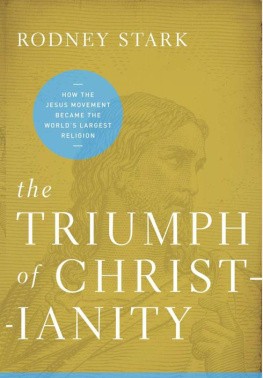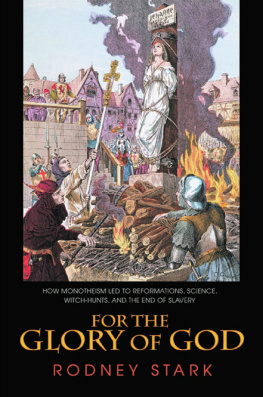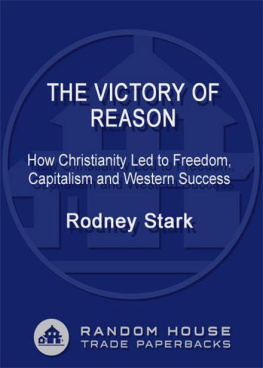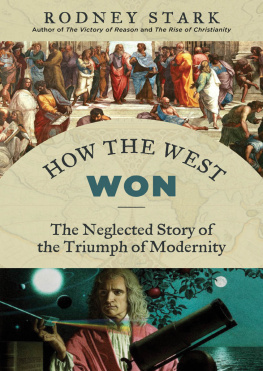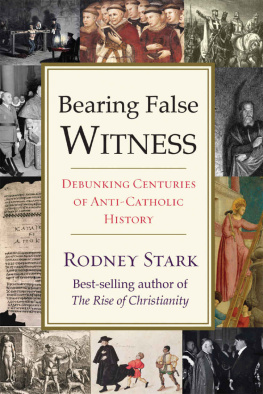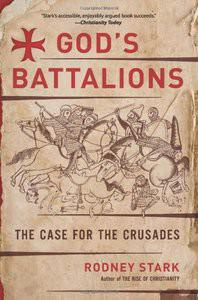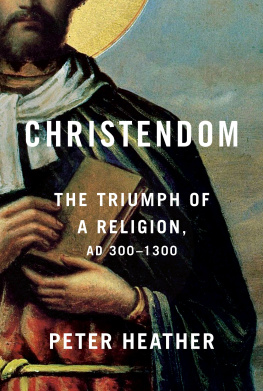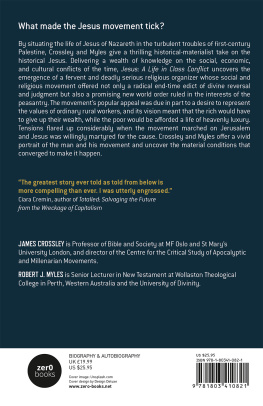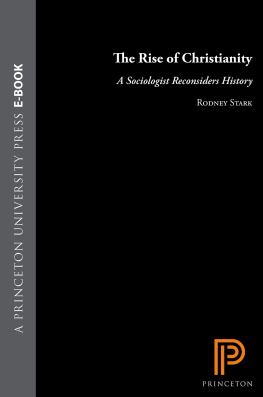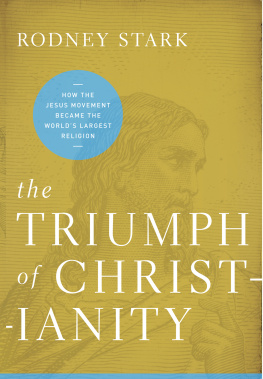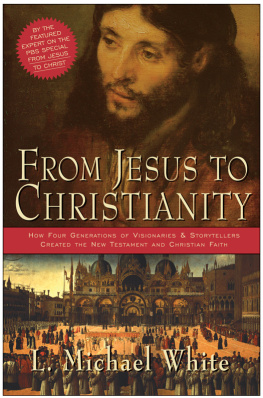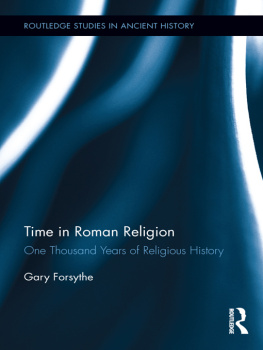THE TRIUMPH
OF
CHRISTIANITY
HOW THE JESUS MOVEMENT
BECAME THE WORLDS LARGEST
RELIGION
RODNEY STARK

Contents
H E WAS A TEACHER AND miracle worker who spent nearly all of his brief ministry in the tiny and obscure province of Galilee, often preaching to outdoor gatherings. A few listeners took up his invitation to follow him, and a dozen or so became his devoted disciples, but when he was executed by the Romans his followers probably numbered no more than several hundred. How was it possible for this obscure Jewish sect to become the largest religion in the world? That is the question that brings us here.
Of course, that question has inspired thousands of other books. Why another? In 1996 I partly addressed that issue in The Rise of Christianity, as I applied some new social scientific principles, considered several overlooked possibilities, and used simple arithmetic to help explain the early success of Christianityhow it conquered Rome. The response to that book by many distinguished reviewers went far beyond my most optimistic imaginings. Even so, in recent years I have become increasingly eager to make a far more extensive visit to Christian history: to start with the religious and social situation prior to Christmas Eve and, instead of stopping with the conversion of Constantine early in the fourth century, to continue on to the present.
I began The Rise of Christianity in about the year 40 CE in order to avoid dealing with questions concerning the historical Jesus and the authenticity of the Gospelsmatters on which I did not then feel sufficiently informed. I ended with Constantine for the same reasonI was not prepared to deal with the whole panorama of Christian history. Since then I have written other books that gave me the opportunity to greatly expand my knowledge and historical competence, so now I am ready to write a far longer book on Christianity that hopefully will seem nearly as fresh and original as the earlier one was said to be.
Although the present book begins with events just prior to the birth of Jesus and ends in the present, it is not another general history of Christianity. Many eras, topics, and prominent persons are skipped. For example, I devote one sentence to the Puritans and none to the Quakers. I barely mention the Orthodox Churches, Henry VIII, John Calvin, or Ignatius Loyola. Little attention is given to theological councils and controversies; I completely ignore the bloody battles over Trinitarianism that erupted in the fifth century. I have, rather, selected important episodes and aspects of the Christian story through the centuries and assessed them from new perspectives.
What do I mean by new perspectives? I mean new answers to old questions and new interpretations of well-known events. Some of these answers and interpretations are based mainly on the work of other scholars whose landmark studies have received far too little attention, but most of the new perspectives are mine or at least partly mine. Although I often dispute the traditional views of what went on and why, I am deeply respectful of the many great scholars who have, through the centuries, contributed to our knowledge of Christian history. I have depended on hundreds of them, as I make plain in the endnotes.
Let me be clear that my concerns are historical and sociological, not theological. While I am not unfamiliar with Pauls theology, for example, my primary concern in this book is not with what Paul believed, but who he was; not with what Paul said, but to whom he said it. Similarly, I will not assess the validity of Luthers disagreement with Rome; my interest is in how he got away with it.
Finally, I have continued to write for the general reader, based on my belief that if I cant say it in plain English, it must be because I dont understand what I am writing about.
Plan of the Book
T HE BOOK IS DIVIDED into six parts.
Part 1: Christmas Eve surveys the religious situation within which Christianity began: the nature of pagan temple societies, the religious makeup of the Roman Empire, and the conflicts going on among the many forms of Judaism that prevailed in Israel.
Part 2: Christianizing the Empire begins with a sketch of what is known about Jesus during his life on earth and then examines the formative days of the movement he inspired. Next is an assessment of the mission to the Jews (which was far more successful than has been recognized) and the mission to the Gentiles (oddly, some of the most basic elements of this mission have been ignored). The next chapter dispels the traditional belief that the early church was recruited from the lowest social strata. To the contrary, as with most new religious movements, early Christianity appealed particularly to people of privilege. Then comes a portrait of the misery of daily life, even for the rich, in Greco-Roman cities. The chapter describes how the commitment of early Christianity to mercy was so effective in mitigating suffering that Christians even lived longer than their pagan neighbors. In addition, most early Christians were women. When the circumstances of pagan and Christian women are compared, the wonder is that all of the women in the Roman Empire didnt flock into the church. Then comes the great irony that Roman persecution made the church much stronger. Finally, a model of Christian growth within the Roman Empire from the year 40 to 350 shows that the most likely rate of Christian growth is very similar to the growth rates achieved by several modern movements.
Part 3: Consolidating Christian Europe starts with the implications of Constantines conversion, suggesting it was at best a mixed blessing that, while ending persecutions, encouraged intolerance toward dissent within the church and greatly reduced the piety and dedication of the clergy. Then comes the demise of paganism. Contrary to tradition, it was not stamped out by Christian persecution, but disappeared very slowly. In fact, paganism may never have entirely died out, and even the presumed conversion of the Northern societies did not occur until nearly a millennium after Christianity became the favored faith of Constantine. By the seventh century, Christianity probably was far stronger and more sophisticated in North Africa and Asia than in Europe. Then came the Islamic onslaught, and eventually Christianity disappeared in many parts of Asia and all but vanished in North Africa and the Middle East. But after more than four hundred years of defensive efforts, in the eleventh century Christian Europe struck back. First, Muslims were driven from Sicily and Southern Italy. Then, the Crusades were launched to liberate the Holy Land. Recent claims that the crusaders really marched east in pursuit of loot and colonies are exposed as malicious nonsense.
Part 4: Medieval Currents first examines the received wisdom that the rise of Christianity ushered in many centuries of ignorance subsequent to the fall of Rome. The work of recent historians shows that not only did Christianity not cause the Dark Ages; nothing did. They never existed, and this era was instead a period of rapid and remarkable progress. Next, the image of deeply pious medieval Europeans is exposed as a total fictionhardly anyone even went to church. Finally, silly claims that Western science managed to arise despite the impediments placed in its way by the church are exposedthe truth is that science arose only in the West because Christianity was essential to its birth.
Part 5: Christianity Divided begins with the rise of two very distinctive and opposed Roman Catholic Churches and contrasts their impact on the outbreak of heretical movements in the twelfth century as well as their brutal repression. Chapter 18 notes that the new religious movements that arose in Europe prior to the fifteenth century are identified as heresies because they failed. Luthers heresy is called the Reformation because it survived. Many prevailing explanations for the origin and success of Luthers Reformation are assessed and some are dispelled. The final chapter in this section reveals that the prevailing image of the Spanish Inquisition as a monstrously bloody and brutal institution is a fiction mainly reflecting Protestant (especially British) hostility toward Catholicism in general, and toward Catholic Spain more specifically. Extraordinary new research based on access to the complete, highly detailed archives of the Spanish Inquisition reveals that the Inquisition caused very few deaths and was mainly a force in support of moderation and restraint. The Inquisition played a major role in ending the witch hunts that swept over other parts of Europe.
Next page
